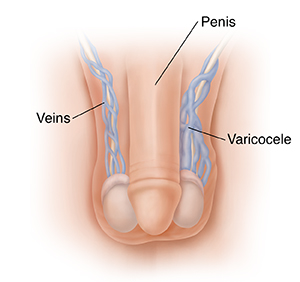A
B
C
D
E
F
G
H
I
J
K
L
M
N
O
P
Q
R
S
T
U
V
W
X
Y
Z
Click a letter to see a list of conditions beginning with that letter.
Click 'Topic Index' to return to the index for the current topic.
Click 'Library Index' to return to the listing of all topics.
Treating Varicocele
A varicocele is when the veins in your scrotum are enlarged. The scrotum is the pouch of skin that holds your testicles. A varicocele is like the varicose veins found in legs but it's in the scrotum.

In most cases, a varicocele isn't serious. Your healthcare provider may wait and watch the problem for a while. If needed, surgery or another procedure is done to close off the enlarged veins. This may be advised if:
Open varicocelectomy
Your healthcare provider may advise surgery to tie off the enlarged veins around the testicles:
-
You're given general anesthesia to allow you to comfortably sleep during the procedure.
-
A cut (incision) is made in the groin or in the lower belly.
-
The veins are then cut and tied off.
-
The cut is closed with stitches, staples, or surgical tape.
Laparoscopic varicocelectomy
Instead of open surgery, laparoscopic surgery may be advised. This is a minimally invasive surgery done through a few tiny cuts. It uses a thin tool (laparoscope):
-
You're given general anesthesia. This will allow you to comfortably sleep during the procedure.
-
A few small cuts are made in the lower belly. The laparoscope is put in through 1 cut. Tiny surgical tools are put in through the other small cuts.
-
The laparoscope sends enlarged pictures to a computer screen. Using these pictures, the surgeon finds the veins that need treatment.
-
The veins are clamped to seal them off.
-
The tools are taken out. The cuts are closed with stitches, staples, or surgical tape.
Microsurgical varicocelectomy
This is another type of minimally invasive surgery that uses a microscope to help identify the veins to be removed. This is done through a small incision in the groin.
-
You're given general anesthesia. This will allow you to comfortably sleep during the procedure.
-
A small cut is made in the groin. Using a microscope the surgeon cuts and ties off small veins.
-
The cut is closed with stitches, staples, or surgical tape.
This surgery takes about 30 to40 minutes. You can go home on the same day.
Percutaneous embolization
In place of surgery, your healthcare provider might advise sealing and blocking the blood flow to the enlarged veins. This is done using percutaneous embolization. A radiologic procedure called a venogram is used to make a map of the veins. A tube is then placed in the large vein in the groin. Materials are injected through this tube into the enlarged veins to block them off using X-ray guidance.
After your varicocele procedure
-
You may feel some pain in your testicle for a few days.
-
Mild swelling and bruising is expected.
-
Mild swelling around the testicle is normal after the procedure. Put an ice pack wrapped in a clean, thin towel on the area to help. Do this for no longer than 20 minutes at a time.
-
Plan to rest for 5 to 7 days. You should not exercise for 10 to 14 days after the procedure. You can return to work after 5 to7 days.
-
If your surgery was done for fertility issues, your semen will be checked 3 to 4 months after the procedure.
When to call your healthcare provider
Call your healthcare provider right away if you have:
-
Ongoing pain not eased by pain medicine
-
Black-and-blue around the cut, bleeding from the cut, or swelling in the scrotum
-
A fever of 100.4°F (38°C) or above, or as advised by your provider
-
Greenish or bad-smelling fluid that leaks from the cut
Risks of varicocele repair
Risks and possible complications of these procedures include:
-
Blood clot
-
Infection
-
Fluid accumulation around testicle (hydrocele)
-
Injury to the nerves in the groin or scrotum
-
Injury to scrotal tissue or structures
-
Injury to the artery that supplies blood to the testicle
-
Risks of general anesthesia, if used
-
Damage to belly structures (laparoscopic surgery)
Online Medical Reviewer:
Marianne Fraser MSN RN
Online Medical Reviewer:
Raymond Kent Turley BSN MSN RN
Online Medical Reviewer:
Rita Sather RN
Date Last Reviewed:
3/1/2024
© 2000-2025 The StayWell Company, LLC. All rights reserved. This information is not intended as a substitute for professional medical care. Always follow your healthcare professional's instructions.